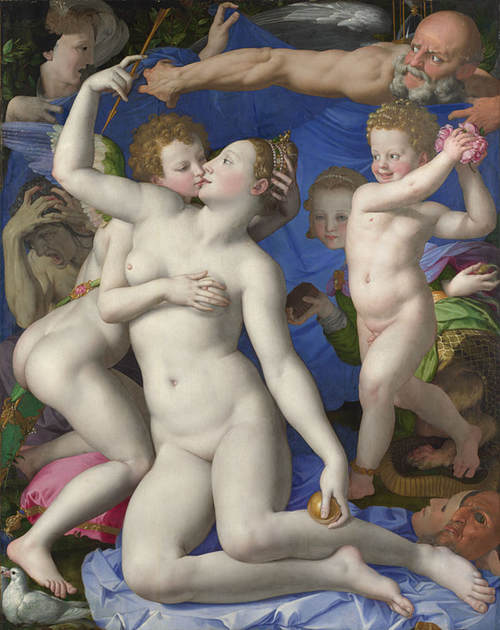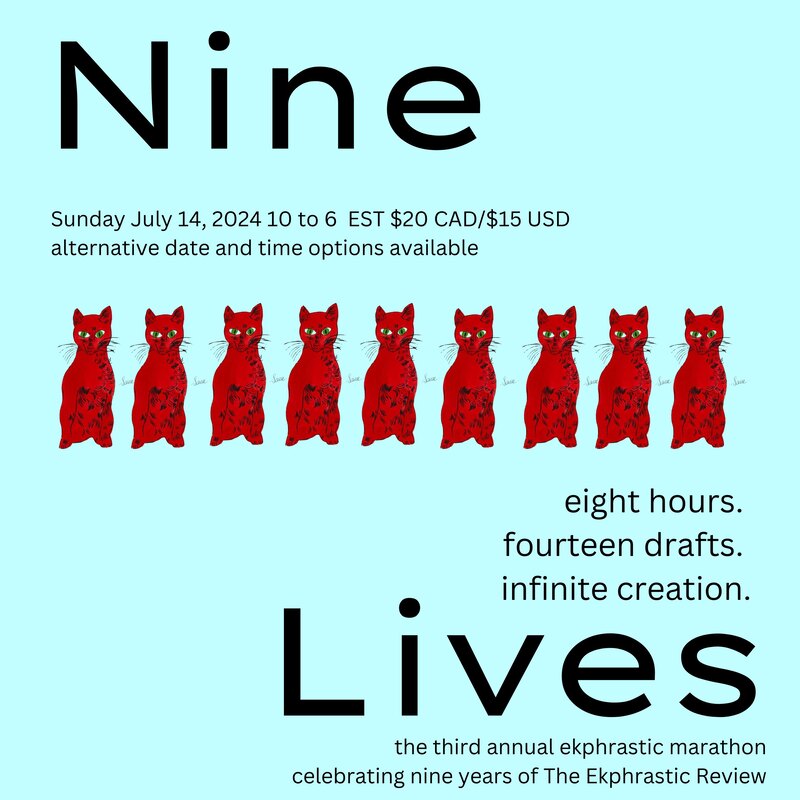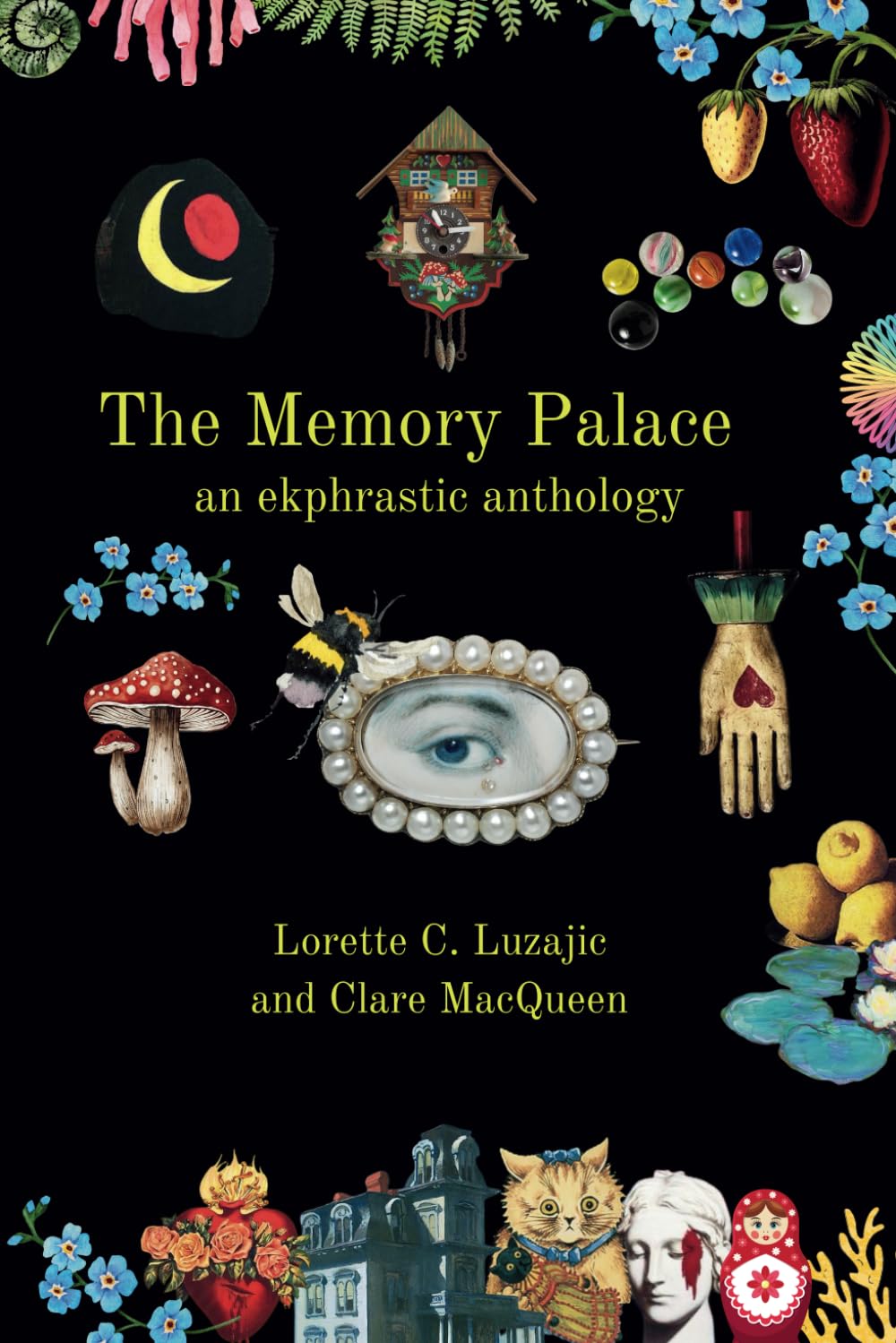|
Frozen Time at London’s National Gallery Taking shelter with a warm cup of tea at the National Cafe on a rainy London day is never a bad idea—coupled with getting lost among the plethora of luring graphics at the National Gallery. While some works seem to summon more viewers than others, there’s a particular painting I keep finding myself at an interface with, while still trying to fathom its meaning. That is none other than the gallery’s most curious, enigmatic, and perhaps even disturbing painting in room 8—or maybe even in the entire National Gallery itself. Constantly drawn towards the same canvas, I read it as a piece of visual poetry where every figure stands for something, and the observer is at the mercy of Venus’s eyes, which continue to tease the contemplator conspicuously about the painting’s hidden meanings. Agnolo Bronzino’s ‘Allegory with Venus, Cupid, Folly and Time’ lacks the typical Renaissance painting’s harmony, structure, and focus--leaving the observer with many things to view, with eyes and minds in a state of perpetual inconclusive wandering. As Venus and Cupid lay there, blatantly enamoured in an almost-kiss--lifelike, not a brushstroke in sight--one cannot help but wonder: ‘what does time have to do with this?’, ‘who’s who?’, or simply, ‘What’s going on here?’ According to Einstein, ‘For us who believe physicists, the distinction between past, present and future is only a stubbornly persistent illusion.’ This idea comes into play in Bronzino’s allegory, where all sense of time is glaciated around and within the figures of Venus and Cupid, and Time is embodied in an allegory incarcerated within the physical boundaries of the painting’s ontic reality. Beyond all this, it is interesting, and maybe even a bit amusing to contemplate this Renaissance masterpiece in terms of some modern philosophical theories on time here and there. While savouring the different hues of colour, we tend to find these theories in a medium where space and time are not absolute, but rather, are represented in a two-dimensional continuum. But the painting’s enigma remains unsolvable…there still is a lack of consensus, a large amount of dissention, and varying degrees of certainty on the identification of the painting’s figures. A spooky, hollow, eyeless, and perhaps brainless figure who’s believed to be Oblivion looms above the couple in the upper left corner of the painting, while below her stoops an anguished figure interpreted as Jealousy (and later on, seen by some scholars as Syphilis). Towards the lower right is a twisted, anatomically distorted ‘lady’ holding honeycomb (pleasure) in one hand and her stinging tail in the other--her twisted posture and serpent tail trick the reader into seeing that her right hand is her left, making her known as the embodiment of Deception. By her side, Folly carries roses toward the couple, while stepping on some thorns himself. However, the major focal figure besides Venus and Cupid is Chronus, or Father Time, the white-bearded figure at the upper right of the painting, with his hour glass on the back of his shoulders and his arms about to move a silk blue drape either away from or over Venus and Cupid. One thing that is for sure in the painting is that Time is present, but he is not perceived or experienced by neither of the two ‘lovers’. Many art historians and other interpreters have seen Time’s gesture with the cloth as an attempt at unveiling the couple, but it can also be seen from an opposite vantage point: an attempt to conceal, rather than reveal. I see Chronus’s gesture in that light, by taking into consideration a modern theory on time--namely that of Sartre. Moving forward a few centuries and having Sartre in mind, the allegory suddenly appears to make a different type of sense to me--albeit one that may be a bit far from the painter’s intentions--as some pieces of this intellectual puzzle begin to fall into place. Both Venus and Cupid appear to be completely unaware of Chronus and the other figures surrounding them (Folly, Deception, Oblivion, and Jealousy/Syphilis) in a complete detachment from both time and their experience of it (temporality), which reminds me of Sartre’s notion on time and the dissociation between chronos (clock time) and kairos (the experiencing of time). According to Sartre, ‘time is, above all, that which separates and the only solution for certain individuals is to freeze time, to stop the clock in order to foreclose the possibility of separation. The result is a present that is completely subsumed by the past and where the possibilities of the future are forever denied.’ Since temporality is a vital factor for the occurrence of separation, the denial of chronological time makes way for fantasies of interminability—on Bronzino’s canvas. The painting is typically mannerist in figura serpentina form, and the figures’ appearances as frozen objects in motion actually helps in portraying this rupture in experiencing time; the relationship between chronos and Kairos is destructed, hence leading to the pausing of time, along with the timeless concepts. Looking again, the concept of ‘freezing’—with the act of Chronus’s concealment of the embracing couple—pervades the painting in many ways. There is an icy coolness in the lascivious eyes and pose of Venus and Cupid, who have not usually been seen embracing in that manner. What also strikes me is that despite the passionate embrace, Bronzino seemed keen on keeping Venus and Cupid in the pale, stony color of cold marble, save for the ears and cheeks, which appear to be the only ‘warm’ spots in pink. Besides Venus’s frozen gaze and her complete dissociation from time and inexperience of temporality, the almost-dropped blue cloth reflects a protective measure--the freezing of time is meant to protect Venus and Cupid from the negative costs of pleasure and a kind of denial of the low qualities of love: Deception and Folly are at the right, along with Oblivion and a gruesome embodiment of Jealousy/Syphilis to the left. Folly’s stepping on the thorns may also signify the dangers of accompanying pain of such ‘love.’ The denial of time through freezing it is not only out of fear of separation, but it is out of Cupid and Venus’s fear of the other viles resulting from their transgressive love. Considering the fact that the painting was a gift from Cosimo de Medici to King Francis the 1st, and knowing the latter king’s love for puzzles and symbols, the motive behind Bronzino’s mystification is quite understandable…and perhaps the role of Time will remain unclear in Bronzino’s allegory. But whether the painting really illustrates this peculiar forbidden love’s denial/freezing of Time or not, there is an obvious break in—or lack of—their perception of it. And so, over a warm cup of tea, we continue the post-museum conversation about the loads of work art history still has ahead …until my brain can only respond by constructing a poem: From a spout among the ebony waves, I shake off a pair of tiny wings. A flutter fans its way out, Glossing away from the raven-dark depths, floating off, away from the confused mass, toward the glowing embers of a mysterious flicker …Like a moth to a flame I do not understand. Roula-Maria Dib Roula-Maria Dib is a university professor at the American University in Dubai where she teaches courses of English language and literature. She has published some poems, essays, and articles in magazines and journals such as Renaissance Hub, The Journal of Wyndham Lewis Studies, Agenda, Two Thirds North, and The Archive for Research in Archetypal Symbolism (ARAS). She is also currently finishing her PhD in Modernist Literature and Psychoanalysis from the University of Leeds in the UK. Her dissertation focuses on Modernist literature (namely the works of James Joyce, Hilda Doolittle, and W.B. Yeats) in light Carl Jung’s psychological theory of individuation, or spiritual transformation. The themes that pervade her work usually revolve around different aspects of human nature, art ekphrasis, surrealism, and the collective unconscious.
0 Comments
Your comment will be posted after it is approved.
Leave a Reply. |
The Ekphrastic Review
COOKIES/PRIVACY
This site uses cookies to deliver your best navigation experience this time and next. Continuing here means you consent to cookies. Thank you. Join us on Facebook:
July 2024
|




